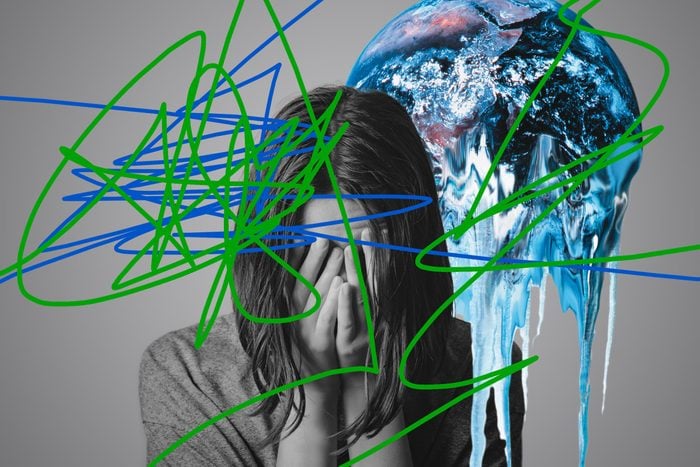What Is Climate Anxiety, and How to Manage It for Peace of Mind
Updated: Dec. 08, 2023

Climate anxiety is a valid response to the very real threats against our environment, and it's especially prevalent in young people. Here's what to do about it.
With our global climate impact reaching an all-time high in 2021, it’s never been clearer that climate change poses the most imminent threat to our environment, and that knowledge is affecting our mental health. Climate anxiety is a very real phenomenon that stems from the overwhelming awareness of human impact on the planet (think: consumption, greenhouse gas emissions, pollution, degradation of natural resources, and use of fossil fuels) as well as a concern about the governmental response to the climate crisis. It’s also known as climate change anxiety, and an affected person may experience an inexplicable sense of despair and helplessness about the future of the planet.
“Climate anxiety means a state of extreme worry about the damage being done to the planet by humans,” says Anouchka Grose, a psychoanalyst in South East London and member of The College of Psychoanalysts. Climate anxiety is particularly prevalent in young people—like millennials and Gen Z—who are more likely to shop eco-friendly brands, worry about their carbon footprint, learn the right way to recycle, and prioritize sustainable living. In fact, a 2021 Nature survey of 10,000 young people—ages 16 to 25—found that 60 percent of respondents reported feeling “very worried” or “extremely worried” about climate change.
But even if we go out of our way to lead green lives—such as conserving water and energy, upcycling our clothes, only purchasing sustainable fish, or better yet, growing our own food—climate change will continue to take a toll on our collective psyches. So, with climate anxiety negatively affecting so many of us, how can we learn to deal with it?
Keep reading to find out what the experts say about how to identify, and what we can do about, climate anxiety.
What is climate anxiety and who does it affect?
Climate anxiety—or climate change anxiety or eco-anxiety—is an awareness of the negative impact human practices have on the environment, an awareness that can feel overwhelming or debilitating at times. It may even be amplified for people of color, who are at higher risk of dying as a result of air pollution, floods, extreme heat, and other consequences of climate change. To make matters worse, climate anxiety may compound their already full load of inherited, generational trauma from institutional racism and white replacement theory.
“For many communities, climate change is far from the first existential threat they have faced,” says Elizabeth Bechard, Senior Policy Analyst at Moms Clean Air Force. “For example, Indigenous communities in the U.S. faced generations of genocide, and Black communities have faced generations of slavery and systemic racism. For these communities, climate anxiety may add to an already sizable burden of anxiety from existing and historic racial inequities.”
Is climate anxiety a real thing?
Just as climate change is a very real thing, so is climate anxiety. “Some people prefer to call it climate grief or climate trauma, as the word anxiety might suggest a condition, pathology, or overreaction,” Grose says. However, since climate anxiety is not a condition that can be diagnosed, it can be tricky to understand or identify. Especially since the symptoms associated with it aren’t always physical. “It’s often used as an umbrella term to capture a wide range of emotions of distress about climate change, and it is absolutely a real thing,” Bechard adds.
In fact, overwhelming feelings associated with climate anxiety can trigger other mental health–related pathologies. A 2021 survey from Yale shows that 70 percent of Americans are at least “somewhat” worried about global warming and exhibit signs of anxiety and/or depression as a result.
“For many people, climate anxiety can manifest as ruminative, distressing thoughts about future climate events,” Bechard explains. “For example, headlines announcing frightening new climate reports or developments (Another melting glacier! Another unprecedented wildfire!) can be profoundly troubling. Some people experience a nagging sense of anxiety, irritability, or grief that they can’t shake; profound anger at people (especially governments or corporations) who aren’t taking action; or a sense of numbness, helplessness, or depression.” It often also manifests as an inability to stop doomscrolling.
Overwhelming concern about the future of our planet is even affecting peoples’ family planning. A 2017 study published in IOP Science finds that one of the four most effective ways to reduce your personal carbon footprint is to have one fewer child. Parents who already have kids may feel guilt or shame about their decision to start a family. Bechard explains, “For parents, climate anxiety may be centered around a sense of fear for our children’s futures and a worry around whether we’ve done the right thing by bringing children into the world.”

How to identify if you have climate anxiety
According to Bechard, symptoms of climate anxiety may include ruminating about future climate events as well as having visceral negative reactions to news about climate change. It can also present as feelings of anxiety, irritability, and grief that are hard to let go of.
Grose provides some examples: “If you’re kept awake worrying about ecological damage, freak out at the sight of heavily packaged imported foods, or don’t believe in any kind of desirable human future, you might be considered to have climate anxiety.”
Bechard also notes that you might feel “shame or guilt about making choices that could have a negative impact on the environment—even when we live in a society in which it’s virtually impossible to make ‘perfect’ environmental choices.” She explains that could mean feeling “anxious or ashamed about driving, visiting a loved one by airplane, or having retirement savings invested in fossil fuel companies.”
The side effects of climate anxiety may be worming their way into our interpersonal relationships as well. “Relationship disruptions can be a symptom of climate anxiety,” Bechard says. “For example, if one person in a relationship is extremely worried about climate change, they might feel frustrated or even angry at their loved one for not sharing the same level of worry or the same level of commitment to climate-friendly behaviors and actions.”
It can make for an interesting dynamic in all couples, but particularly in heterosexual relationships. A 2018 study from Mintel identifies a very real phenomenon called the “eco gender gap.” The results show that 71 percent of British women prioritize living more ethically and sustainably than they did a year ago, compared with only 59 percent of men. Sustainability and environmental issues have long been considered a “women’s fight,” and the data clearly suggests that climate issues are more likely to move women to climate action.
How to deal with climate anxiety
If you suspect you may be experiencing climate anxiety, the first step in dealing with it is to recognize that you’re not alone. Even the most eco-friendly countries aren’t getting everything right.
“Climate anxiety is a normal response to the conditions that are actually happening in the world,” Bechard explains. “We feel anxiety when something we care about is under threat, and because climate change actually does threaten what we care about, climate anxiety is an entirely appropriate response.”
One thing that can help is reframing your mindset about why you have climate anxiety. Bechard believes you can reframe it as an expression of love. “Our distressing climate emotions, like climate anxiety and grief, are reminding us that we are humans who care deeply about our loved ones, our communities, and the planet,” she says.
Looking for other like-minded individuals is another meaningful coping method. And if you can’t find any within your own community, you can always join a community specifically designed for people struggling with climate anxiety.
Bechard recommends reaching out to the Good Grief Network, a group that helps people process their climate emotions in a supportive group format. You can also join a Climate Café, another facilitated group gathering for people with climate emotions, or seek care from a climate-aware therapist who has received specialized training on the topic. Finally, Bechard recommends visiting AllWeCanSave.Earth for more impactful resources on dealing with climate anxiety.
How to help others who may be experiencing climate anxiety
Looking to support someone else while they struggle with climate anxiety? “The most helpful thing to do for people with eco-anxiety is to listen to them, acknowledge their reality, and don’t try to downplay their fears,” Grose explains. “You could also support them in finding useful forms of engagement or activism, so they don’t feel so helpless.”
In fact, taking part in collective environmental activism has shown to provide relief from climate anxiety and depression, according to a 2022 study published in Current Psychology. That could mean joining a climate group, attending a protest, or working with others to contact policymakers. There are also tons of people and organizations responding creatively to climate change in their communities, like this organization that upcycles beach trash in Hawaii, this nonprofit that reduces waste by transforming partially used soap bars from hotels, and this woman who is living plastic-free.
Bechard explains why group efforts are so important: “[W]hen we see other people taking climate action, this can help build our own sense of hopefulness.” She goes on, “Knowing that people around the world are working day in and day out on climate change renews my sense of faith that we can still positively impact the future, even when the headlines are grim.”

What we can do about climate anxiety
No single person can cure the climate crisis, but we can each make changes in our individual lives to combat it (and ease our climate anxiety in the process). We can also look at the larger, positive, steps that are being taken, like California’s implementation of a gas car ban to help combat climate change and reduce emissions.
“The best thing to do about eco-anxiety is to take it seriously and to act on it,” Grose says. “For instance, if you work for an environmentally irresponsible company that refuses to change, start looking for another job. Maybe move your bank account or pension to an ethical one. Make small changes and big ones—whatever you can do that leaves you able to keep functioning.” Investing in an eco-friendly car and avoiding fast fashion are big steps toward reducing your personal emissions, but using reusable water bottles or grocery bags are easy ways to make changes today.
It can also help to reframe “What can we do?” as both short-term and long-term goals. “What can we do?” in the short-term means coping in the moment, while in the long-term, it’s a question of campaigning for more eco-friendly policies that move the needle.
In the short term, it can be helpful to focus on mindfulness practices, just as you would when dealing with generalized anxiety or depression. Deep breathing, using a meditation app, or even spending time in nature can help reduce overwhelming feelings of anxiety.
But there’s also a much bigger fish to fry when it comes to a solution for climate anxiety in the long-run. “On a broad scale, we need urgent, effective action on climate change from governments and large corporations,” Bechard says. “Research tells us that for young people, government inaction on climate change is one of the biggest drivers of climate distress. To meaningfully address climate anxiety and other forms of climate distress, we need our elected representatives to do their jobs and take climate action now.”
And since climate change is impacting our mental health in a very real way, it also becomes a matter of implementing better, more appropriate health care.
“We also need a more functional mental health care system in which everyone has access to high-quality, trauma-informed, climate-aware mental health care. This is far from our current reality,” Bechard explains. “We need health care providers at every level to be trained to understand the mental health impacts of climate change and to be able to respond to patients and communities with compassion and skills.”
5 tips to reduce climate anxiety
Feeling anxious or overwhelmed about the future of our planet? Try these five actionable tips for reducing climate anxiety.
1. Remember that every small action counts
It’s true. Even when it feels like you’re not doing enough—like no one’s doing enough—on behalf of the planet, you’re doing what you can, and that’s got to count for something. Effective small actions include recycling properly, composting, and choosing a reusable straw.
“Don’t let people talk you out of individual actions like eating a plant-based diet or driving less,” Grose says. “You don’t have to drive yourself crazy doing everything—just do what you can.”
2. Practice mindfulness
Mindfulness is always a good idea—no matter what kind of stress or anxiety you’re experiencing. It’s not a coping mechanism unique to climate anxiety, but it works just the same.
“In the moment, somatic practices for helping to calm the nervous system can be very helpful,” Bechard says. “This might be as simple as lengthening our exhales so that they’re longer than our inhales, which can help create a sense of calm.”
Bechard adds, “Many people find mindfulness practices a helpful tool in managing climate distress, as mindfulness can teach us to observe our emotions and see that they naturally ebb and flow—rather than identifying with them as though we are our emotions.”
3. Find support in communities
There are plenty of supportive communities out there for people with climate anxiety. You just have to find them! Refer to Bechard’s list of resources to find a community that works for you—even as you struggle with climate anxiety.
“Being in community with others who care about climate change can be incredibly helpful for managing climate anxiety, especially in spaces where it’s safe to express our full range of emotions about climate change,” Bechard adds.
4. Take part in climate action
Doing good for the environment can make you feel better—even when in the throes of a climate-related panic. Showing you care in an actionable way will not only have an impact on your community and environment, but it’ll also have an impact on your well-being and overall state of mind.
“Finding ways to take climate action that aligns with your own resources, strengths, skills, and interests is also a really important way to help manage your individual climate distress,” Bechard adds. These social media climate activists may offer some steps you can model in your own life.
5. Connect with nature
It may seem counterintuitive to spend time in nature given that the environment is the thing causing your stress. But still, connecting with nature can be a helpful tool.
“Going outside and connecting with nature, if that isn’t triggering (e.g., due to an extreme weather condition, like wildfire smoke), can be healing and grounding,” Bechard explains. Visit a national park or just get to know your neighborhood garden or park.

How do you treat climate anxiety?
Climate change therapy may be a viable option in your area. “Climate-aware therapists are an incredible resource for people struggling with climate anxiety, and the Climate Psychology Alliance has created an ever-growing national directory,” Bechard says. “However, it’s important to acknowledge that for many people, climate-aware therapy remains inaccessible for many reasons, whether that’s cost or availability. For example, at the time I’m writing this, there are only four climate-aware therapists in the whole state of North Carolina where I live! Accessing climate-aware therapy is a privilege.”
Alternatively, joining some kind of climate anxiety support group may be exactly the kind of treatment you’re looking for. Grose recommends the “Good Grief Network group, Climate Café, a climate action group, or some other form of connection with others where it’s safe to express emotions about climate change.” She adds, “Climate anxiety is something many of us are likely to be navigating for a long, long time, and we need and deserve support.”
How can I avoid climate anxiety?
Both Grose and Bechard agree that we shouldn’t be trying to avoid climate anxiety, but rather tackling its root causes head-on.
“Avoiding climate anxiety isn’t necessarily the right goal. Anxiety is an emotion we experience when something we care deeply about is under threat, and since climate change does threaten what we care about, it’s actually an appropriate, healthy response to what’s happening in the world,” Bechard explains. “When we try to numb out our experiences of anxiety or grief with constant distractions, we also begin to numb our experiences of care and love. And we really can’t afford to lose access to our sense of love for each other and the planet. This love is what’s going to fuel the climate solutions we need.”
Grose adds, “Don’t try to avoid climate anxiety. That’s just irresponsible. You have to face your fear and use it to inform your actions. It might sound like a big ask, but it’s better than pretending it isn’t happening and then finding out it is!”
Conclusion
Climate anxiety is very real and affecting many people’s mental health. While it can be difficult to navigate the overwhelming feelings of guilt, sadness, grief, anger, and helplessness that oftentimes come with climate anxiety, it’s important to remember you’re not alone. There are support groups, communities, and climate-aware therapists to help support you as you deal with climate anxiety.
To learn more about living a sustainable lifestyle, start with this guide to reducing your food waste.
Sources
- United Nations World Meteorological Organization: “State of the Global Climate 2021”
- Anouchka Grose, psychoanalyst in South East London and member of The College of Psychoanalysts
- Nature: “Young people’s climate anxiety revealed in landmark survey”
- Princeton Student Climate Initiative: “Racial Disparities and Climate Change”
- Elizabeth Bechard, Senior Policy Analyst at Moms Clean Air Force
- Yale Program on Climate Change Communication: “Climate Change in the American Mind”
- IOP Science: “The climate mitigation gap: education and government recommendations miss the most effective individual actions”
- Mintel: “The Eco Gender Gap”
- Current Psychology: “Climate change anxiety and mental health: Environmental activism as buffer”



